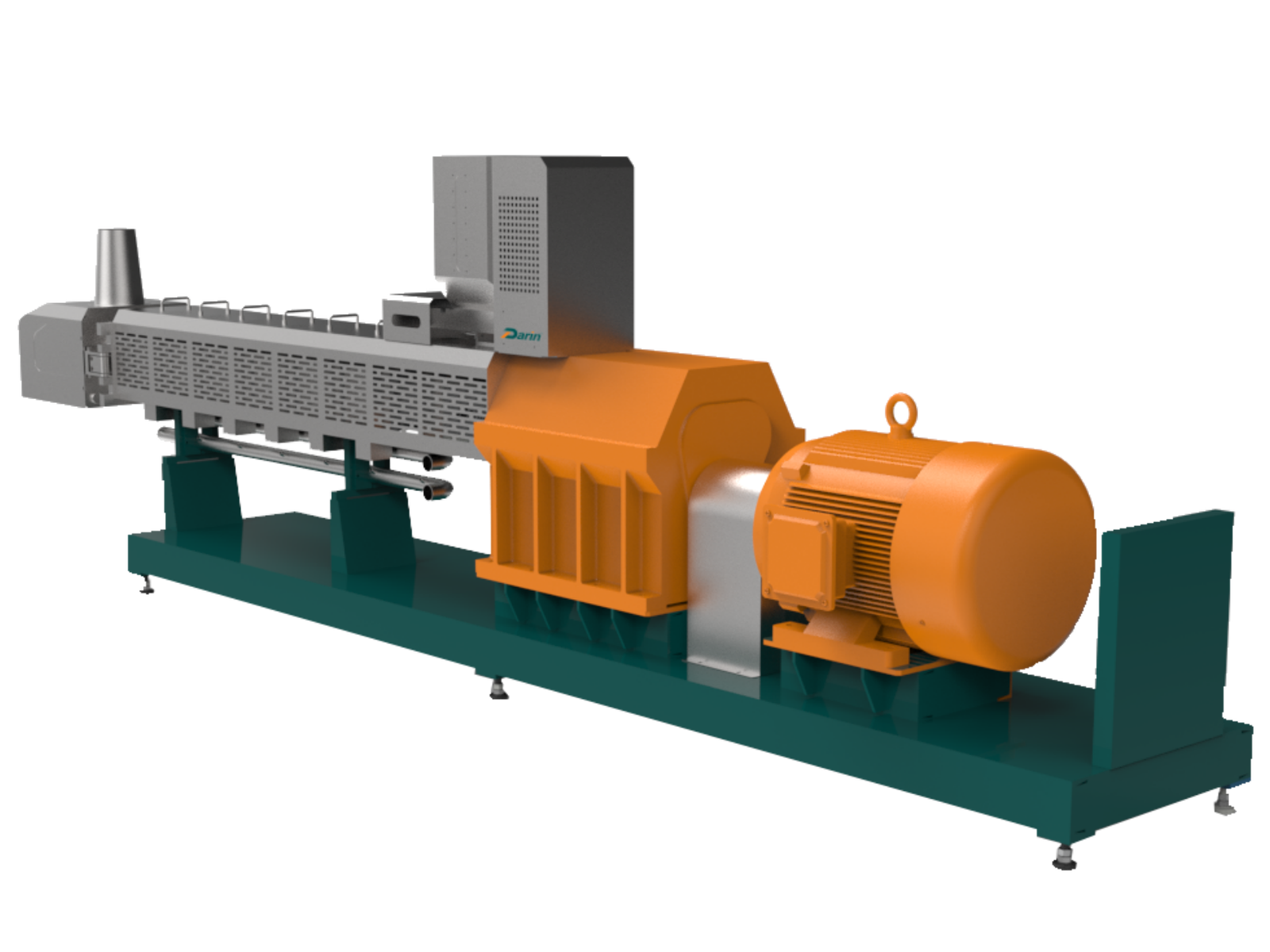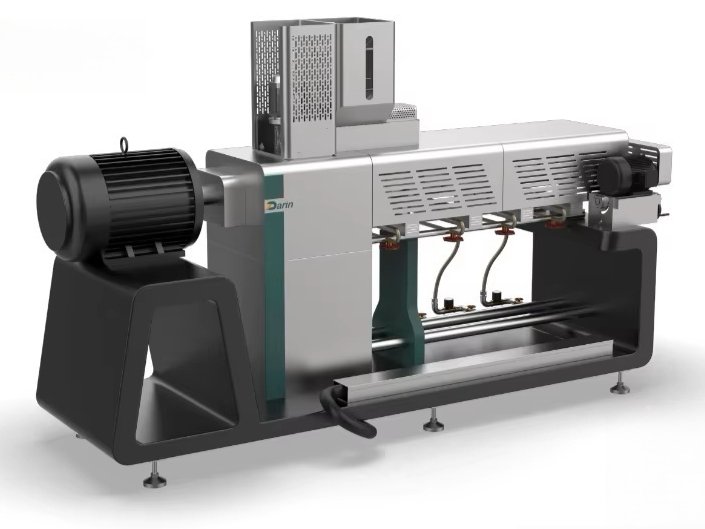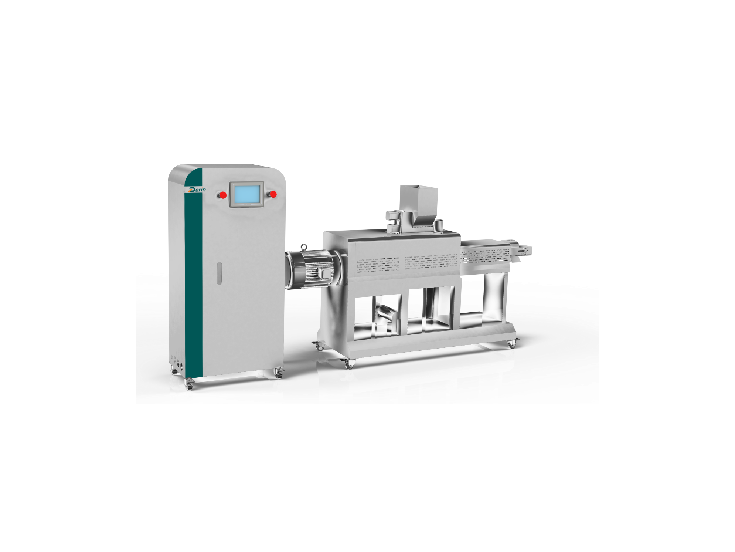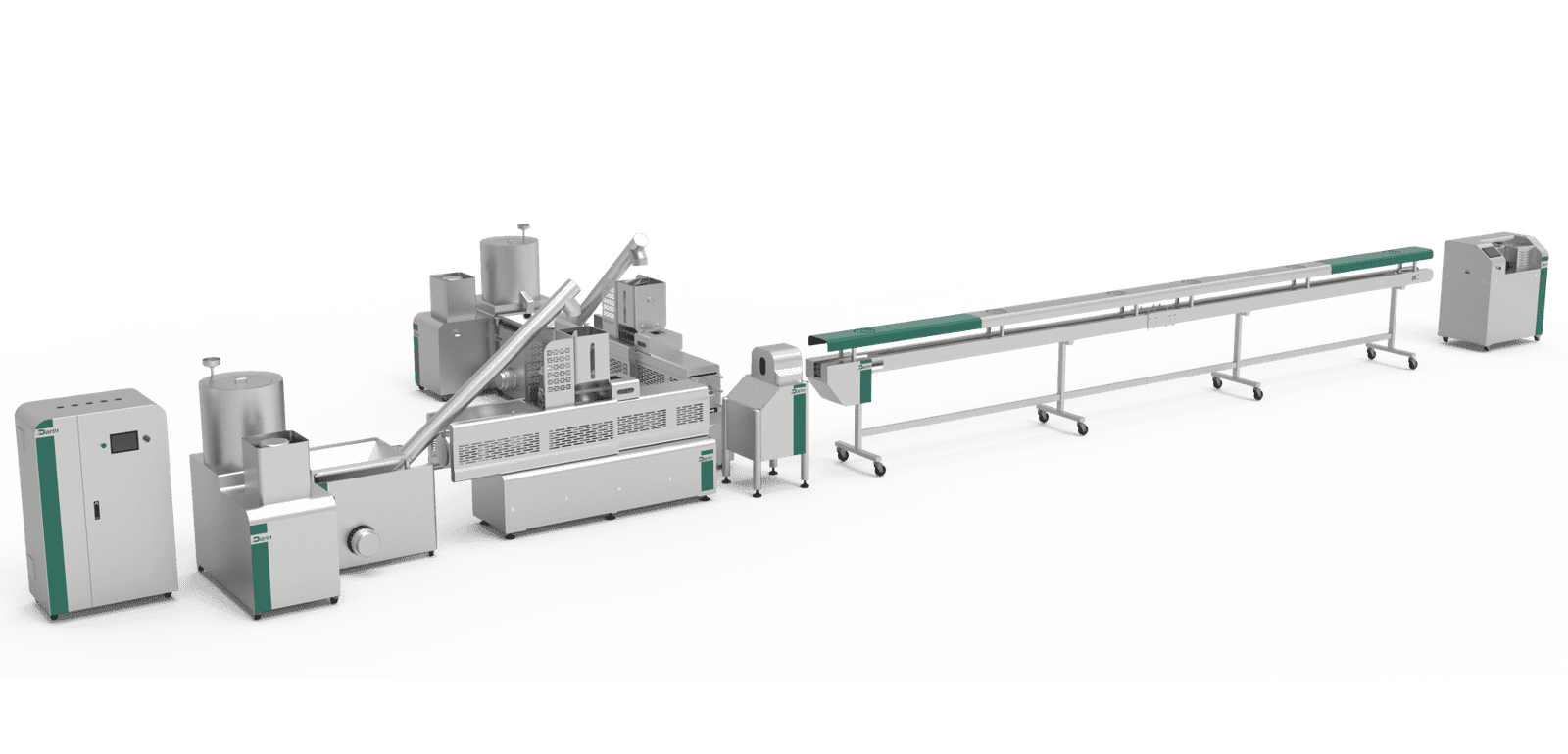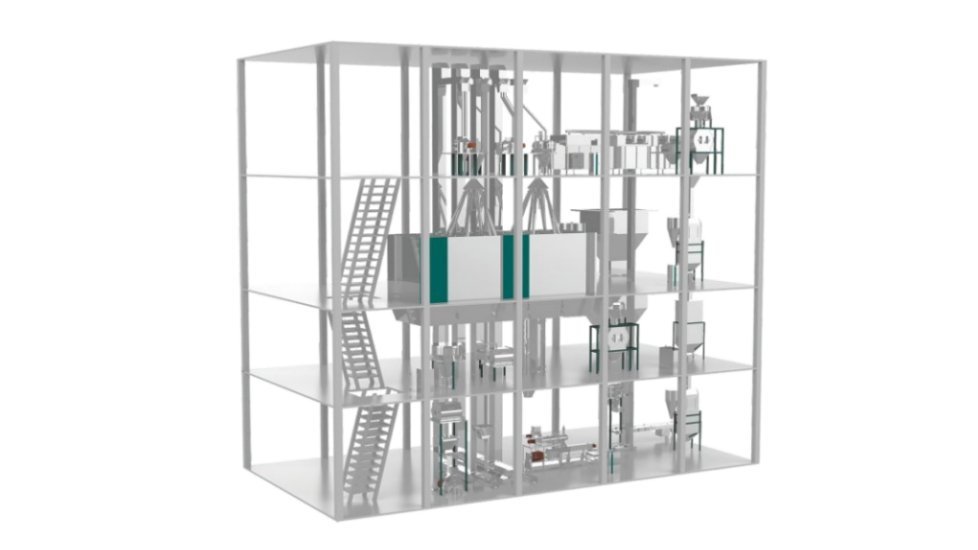
Producing dog food is far more complex than simply mixing ingredients and heating them. Pet owners increasingly expect human-grade quality, consistent nutrition, and appealing taste — yet many small factories struggle with irregular texture, poor expansion, or contamination risks. These problems arise when ingredients are unbalanced, equipment is mismatched, or process control is lacking. In contrast, professional manufacturing follows a scientific, step-by-step procedure that ensures food safety, digestibility, and market competitiveness. This guide explains how modern factories, such as those using Darin Machinery’s advanced extrusion lines, produce dry, semi-moist, and canned dog foods efficiently and safely.
Dog food is manufactured through a controlled series of stages including raw material preparation, mixing, extrusion or cooking, drying, coating or sterilization, and final packaging. Each type — dry, semi-moist, or canned — uses specific temperature, moisture, and pressure parameters. Industrial producers rely on twin-screw extruders, dryers, vacuum coaters, and retort sterilizers to guarantee consistent texture, nutrient stability, and long shelf life.
Whether you plan to establish a new dog food factory or upgrade an existing one, understanding this systematic process is vital. In the following sections, you’ll learn each phase in detail, including technical parameters, recommended machinery models, and real-world manufacturing practices used globally by leading pet food producers.
Modern dog food production lines always include an extrusion or cooking step to sterilize and shape the food.True
Extrusion or cooking under high temperature and pressure destroys pathogens, gelatinizes starch, and forms stable kibble structures.
Dog food can be produced efficiently without any drying process.False
Drying reduces moisture to below 10%, preventing mold growth and ensuring long-term shelf stability.
Step 1. Raw Material Selection and Preparation
Producing quality dog food begins with scientific ingredient selection. Formulation must meet nutritional needs, palatability expectations, and cost constraints.
Typical Ingredient Categories
| Category | Common Examples | Main Function |
|---|---|---|
| Protein sources | Chicken meal, fish meal, lamb, beef, soybean meal | Provide amino acids and tissue-building nutrients |
| Carbohydrates | Corn, rice, wheat, cassava, sweet potato, peas | Supply energy and aid kibble structure |
| Fats & oils | Animal fat, fish oil, sunflower oil, tallow | Enhance flavor and energy density |
| Fiber & binders | Beet pulp, cellulose, bran | Support digestion and shaping |
| Vitamins & minerals | Premixes, calcium carbonate, phosphorus | Maintain health and metabolism |
| Additives | Antioxidants, palatants, colorants, emulsifiers | Stabilize and enhance product appeal |
Before entering the production line, raw materials must be tested for protein content, moisture, aflatoxin, and microbial contamination.
High-protein meals are sieved to remove impurities, and grains are cleaned with a destoner or magnetic separator.
Grinding
Uniform grinding enhances digestibility and extrusion consistency.
A hammer mill or pulverizer reduces particle size to 0.25–0.6 mm depending on formula.
Too coarse leads to irregular kibble; too fine increases energy use and dust.
Modern Darin systems integrate:
- Automatic feeding conveyors
- Pulse dust collectors for air cleanliness
- Magnetic separators for metal removal
The ground meal is stored in stainless bins with level sensors and temperature monitoring to prevent condensation.
Step 2. Weighing, Dosing, and Mixing
Consistency starts with precise formulation. Automated weighing systems ensure that each ingredient enters in the correct ratio.
Weighing and Dosing
The process is controlled by a PLC batching system, which selects each ingredient based on recipe data.
Accuracy should reach ±1% for major ingredients and ±0.2% for micro-additives.
Mixing Process
Dry ingredients are transferred to a horizontal ribbon blender or double-shaft paddle mixer.
Mixing time: 90–180 seconds
Target uniformity: CV ≤ 5%
Liquid oils or molasses can be sprayed through atomizing nozzles for homogeneity.
| Parameter | Standard Range | Impact |
|---|---|---|
| Moisture after mixing | 8–12% | Ideal for extrusion |
| Mixing temperature | <40°C | Protects vitamins |
| Uniformity index (CV) | ≤5% | Prevents inconsistent extrusion flow |
After mixing, the batch is conveyed via a sealed screw feeder to prevent contamination and moisture gain.
Tip: Over-mixing increases frictional heat and nutrient loss. Optimal mixing ensures consistent feed density and uniform kibble color after extrusion.
Step 3. Extrusion or Cooking — The Heart of Dog Food Production
Extrusion transforms raw material into digestible, sterile, and expanded kibble.
It is the core technology differentiating industrial dog food from homemade meals.
Extrusion Principles
In a twin-screw extruder, ingredients are mixed, compressed, heated, and sheared under controlled temperature and pressure.
Starch gelatinization and protein denaturation occur, improving digestibility.
When the cooked dough exits through the die, sudden pressure drop causes water vaporization — expanding the product into a porous structure.
Darin Machinery Extruder Models
| Model | Capacity (kg/h) | Main Power (kW) | Screw Dia (mm) | Application |
|---|---|---|---|---|
| DR-65 | 120–150 | 22 | 65 | Small & medium pet food lines |
| DR-70 | 200–300 | 30 | 70 | Standard commercial production |
| DR-85 | 400–600 | 55 | 85 | Large-scale plants |
| DR-95 | 800–1200 | 90 | 95 | Industrial-grade continuous operation |
All models feature frequency-controlled motors, automatic temperature zones, and stainless-steel barrels.
Typical Extrusion Parameters
| Variable | Range | Purpose |
|---|---|---|
| Temperature | 120–160°C | Ensures starch gelatinization |
| Moisture | 20–25% | Balances expansion and texture |
| Screw speed | 300–600 rpm | Controls density and throughput |
| Pressure | 3–6 MPa | Ensures uniform shaping |
| Retention time | 20–40 s | Guarantees sterilization |
Different recipes require parameter adjustments:
- High-meat formulas: lower temperature (120–130°C) to protect amino acids
- Grain-free diets: longer residence time to achieve full starch cooking
Extruders may include vacuum feeding, liquid injection ports, and steam conditioning systems to enhance plasticity and throughput.
Step 4. Cutting and Shaping
At the extruder outlet, a rotary cutting system slices the extrudate into defined sizes and shapes. The die design dictates product geometry.
Common Dog Food Shapes
| Shape | Use | Market Appeal |
|---|---|---|
| Round pellets | Standard dry kibble | Simple, low cost |
| Bone shape | Dental treats | Familiar and fun |
| Star / Heart | Premium snacks | Emotional connection |
| Flat discs | Soft feed or puppy diets | Easy chewing |
Cutting speed is synchronized with screw rotation using an inverter system to maintain uniform size.
Die plates are made from wear-resistant alloy steel for longevity.
Changeover Flexibility:
Darin extruders allow fast die replacement — within 10 minutes — enabling multiple product SKUs from a single line.
Semi-Moist Products
Semi-moist extruded foods require lower drying intensity and higher final moisture (15–25%), often combined with humectants such as glycerin or sorbitol.
These products retain chewiness and are packed in vacuum or nitrogen-filled pouches to prevent spoilage.
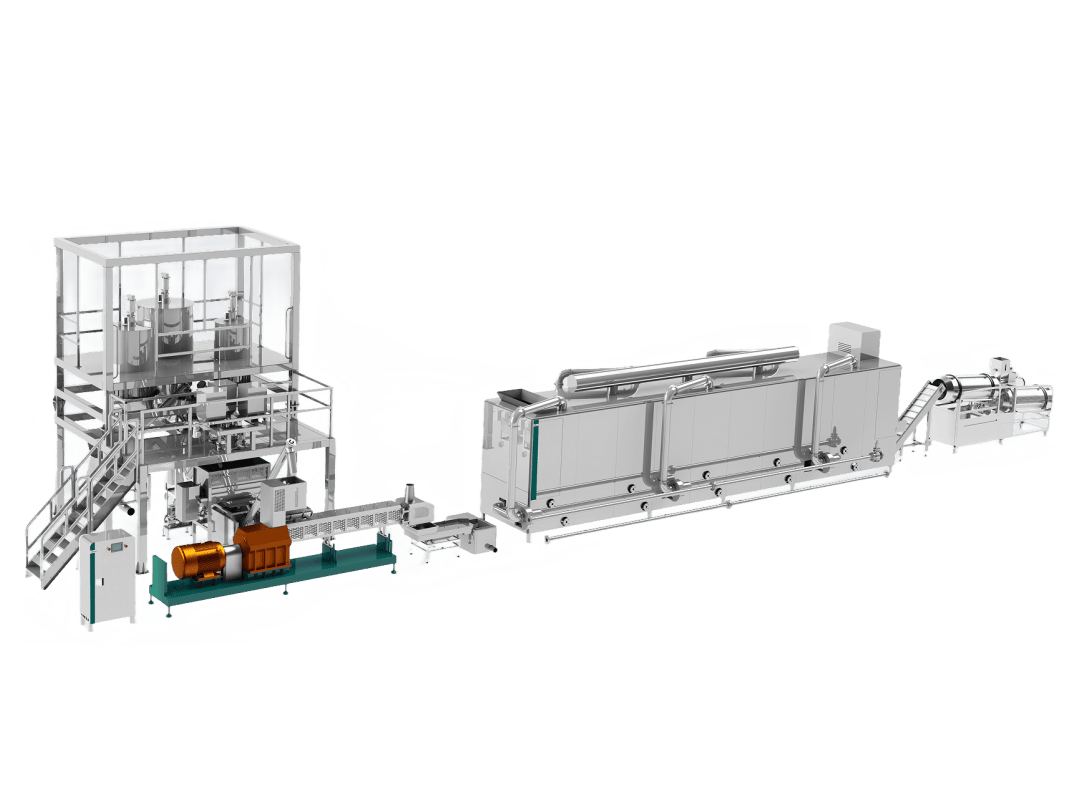
Step 5. Drying and Moisture Control
Once shaped, dog food must be dried to a stable moisture content.
Drying directly impacts shelf life, product stability, and palatability.
Drying Principles
Hot air removes water from the product through evaporation.
Uneven drying causes color variation and mold growth, while excessive heat can destroy vitamins.
Equipment:
- Multi-layer belt dryer (5–7 layers)
- Continuous rotary dryer for large capacities
- Gas or steam heating systems
| Parameter | Standard Range | Function |
|---|---|---|
| Inlet temperature | 110–130°C | Rapid surface drying |
| Outlet temperature | 50–60°C | Prevent cracking |
| Residence time | 15–45 min | Depends on product thickness |
| Final moisture | 8–10% | Ideal for packaging |
Moisture Monitoring
Modern dryers are equipped with infrared sensors and PLC control for automatic adjustment.
Maintaining uniform airflow and layer thickness ensures stable drying efficiency.
Energy Efficiency
Using heat recovery systems from exhaust gases can save 15–25% energy.
Insulated panels reduce thermal loss and improve factory sustainability.
| Energy Source | Advantage | Efficiency |
|---|---|---|
| Natural gas | Fast response | 85–90% |
| Steam boiler | Even temperature | 80–85% |
| Electric heater | Precise control | 95% but higher cost |
Example: Darin Multi-Layer Dryer
- Model: DR-5D
- Layers: 5 stainless mesh belts
- Heating: Gas / Steam
- Capacity: 300–1000 kg/h
- Moisture control: automatic feedback loop
Proper drying produces crisp, low-moisture kibble ready for flavoring or packaging. For semi-moist and canned foods, the drying step differs:
- Semi-moist: partial drying to 20–25% moisture
- Canned: no drying; sterilization happens later via retort

Step 6. Flavoring and Oil Coating
After drying, dog food kibble may appear nutritionally complete but lacks the enticing aroma and taste dogs love. This is where flavoring and oil coating come in — a decisive stage for palatability and market acceptance.
Purpose of the Coating Process
Coating enhances aroma, taste, and nutritional appeal. It typically includes:
- Animal fats or oils for mouthfeel and energy
- Palatants (flavor enhancers) like hydrolyzed liver or yeast extracts
- Vitamin or mineral premixes for nutritional enrichment
- Colorants for visual appeal (optional)
Key Fact: Palatability can increase by over 40% after proper coating, directly influencing customer loyalty.
Darin Machinery Coating Systems
Darin offers both rotary drum coaters and vacuum oil coaters for different production needs:
| Model | Type | Capacity (kg/h) | Features |
|---|---|---|---|
| DR-C500 | Rotary drum coater | 300–500 | Simple structure, easy cleaning |
| DR-C1000 | Rotary drum coater | 800–1000 | Suitable for dry kibble |
| DR-V500 | Vacuum coater | 400–600 | Uniform internal absorption |
| DR-V1000 | Vacuum coater | 800–1000 | Best for premium high-fat diets |
Vacuum coating is ideal for high-protein or grain-free recipes, where oil must penetrate deep into porous kibble for stable distribution.
Coating Parameters
| Variable | Recommended Value | Impact |
|---|---|---|
| Product temperature | 40–50°C | Optimal for absorption |
| Oil dosage | 3–6% | Adds energy and flavor |
| Palatant dosage | 0.5–1% | Improves aroma |
| Coating duration | 3–5 min | Ensures uniform coverage |
Coating Procedure
- Kibble enters the rotating drum or vacuum chamber.
- Nozzles spray oil and palatant evenly.
- Gentle tumbling ensures complete coating.
- Optional: cool air is passed to fix the coating layer.
Result: Shiny, aromatic, nutritionally balanced kibble ready for packaging.
For semi-moist dog food, coating can include glycerin, sorbitol, or humectant mixtures. These prevent drying and maintain chewy texture, with moisture stabilized between 15–25%.
For canned food, flavoring is integrated in the gravy or jelly formulation before sterilization.
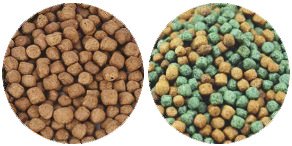
Step 7. Cooling and Sieving
Once coated, the product temperature must be reduced to prevent condensation and spoilage during packaging.
Cooling Process
Cooling solidifies fat layers, stabilizes structure, and improves storage life.
Equipment Used:
- Counterflow coolers (for dry dog food)
- Ambient conveyor coolers (for semi-moist foods)
- Chilled air coolers (for large-scale plants)
| Parameter | Ideal Range | Purpose |
|---|---|---|
| Air temperature | 15–25°C | Prevent oxidation |
| Cooling duration | 8–15 min | Stabilizes structure |
| Final product temp | <30°C | Safe for packaging |
| Relative humidity | <60% | Avoid condensation |
Working Principle
Cool, filtered air moves counter-current to the warm kibble. The product gradually cools to near ambient temperature, minimizing thermal shock.
A cyclone separator removes dust and fines generated during cooling.
Sieving
After cooling, products are screened using a vibrating sieve or rotary separator. Oversized or undersized particles are recycled back into the production line.
| Purpose | Equipment | Description |
|---|---|---|
| Size uniformity | Vibrating screen | Removes fines or agglomerates |
| Dust removal | Air blower | Maintains hygiene |
| Reuse system | Screw feeder | Returns waste to mixer |
Benefits:
- Prevents packaging issues
- Enhances visual consistency
- Reduces waste and improves yield

Step 8. Packaging and Storage
Packaging is the bridge between production and the market. It protects product quality, extends shelf life, and communicates brand identity.
Dry Dog Food Packaging
For dry kibble, moisture and oxygen are the main enemies. Packaging must ensure airtight sealing and light protection.
| Packaging Type | Common Size | Material | Benefit |
|---|---|---|---|
| Pillow bag | 500g–10kg | PET/PE film | Economical and flexible |
| Quad-seal bag | 5–25kg | Aluminum laminate | Long shelf life |
| Stand-up pouch | 100g–2kg | Multi-layer film | Attractive and resealable |
| Bulk bag | 25–50kg | Woven PP | Industrial applications |
Darin Automatic Packaging Line
- Model: DR-P1200
- Weighing accuracy: ±2g
- Packing speed: 10–25 bags/min
- Optional nitrogen flushing for oxidation prevention
Packaging Steps:
- Product enters buffer hopper.
- Multi-head weigher measures exact portion.
- Automatic form-fill-seal machine creates the bag.
- Heat sealing ensures airtight closure.
- Metal detector and checkweigher ensure safety and accuracy.
Final Moisture for Dry Food: 8–10%
Storage Conditions: 15–25°C, RH < 60%, away from sunlight.
Semi-Moist Dog Food Packaging
For semi-moist food (15–25% moisture):
- Vacuum packaging or nitrogen injection prevents mold.
- Laminated pouches with oxygen barriers (EVOH/PE) extend shelf life.
- Shelf life typically ranges from 6–12 months.
Canned Dog Food Packaging
Canned food uses metal tins or aluminum trays. After filling with gravy or jelly, lids are sealed hermetically.
Filling Process:
- Sterilized containers are filled with cooked meat-grain mixture.
- Gravy or broth added to achieve desired texture.
- Air evacuated and lid sealed.
- Cans sterilized in a retort autoclave.
| Sterilization Parameter | Standard Value |
|---|---|
| Temperature | 121°C |
| Pressure | 0.15 MPa |
| Duration | 30–40 min |
| Cooling | Gradual, with filtered water |
This process ensures complete microbial safety and a 2-year shelf life.
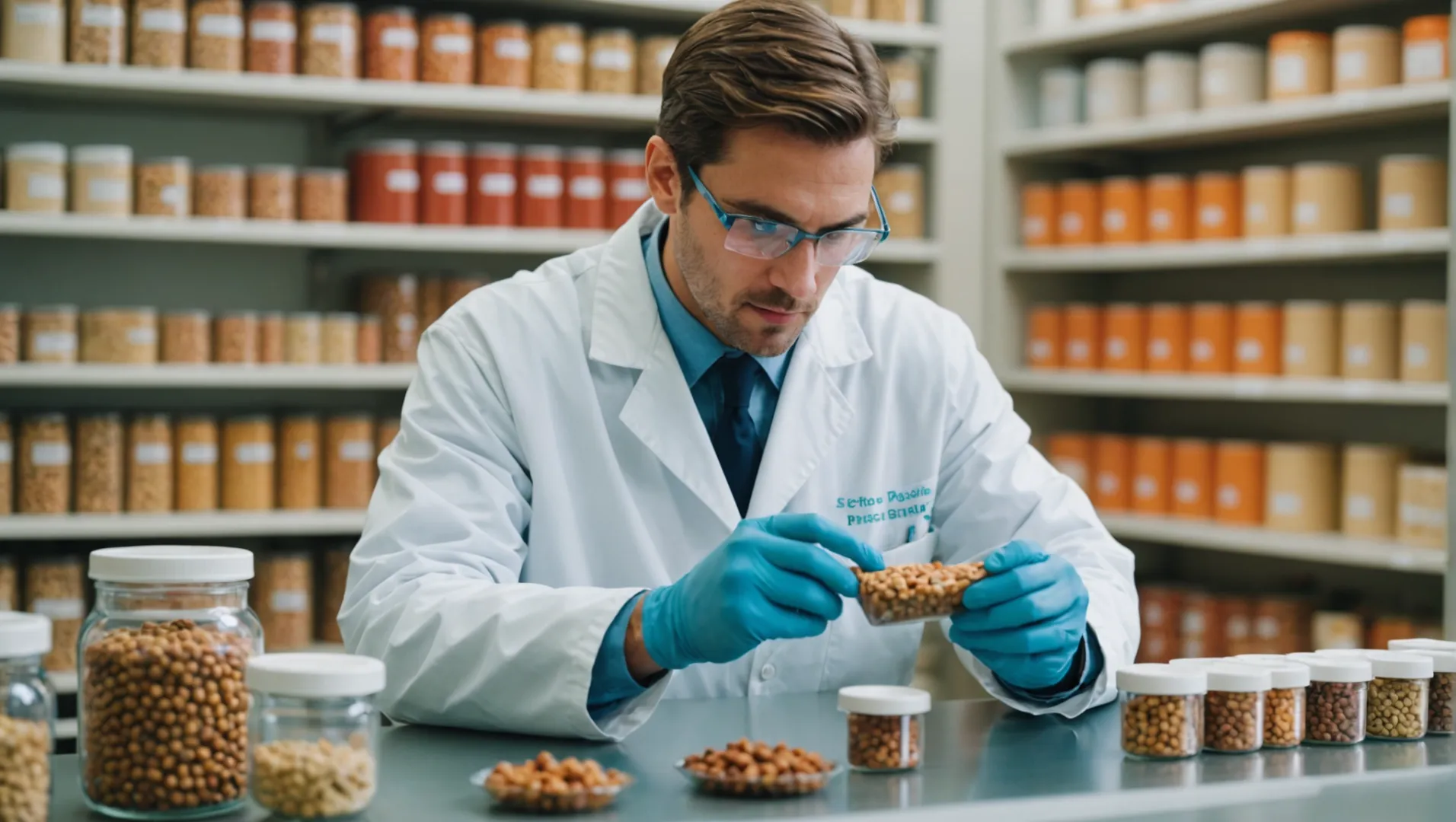
Step 9. Quality Control and Nutritional Testing
Producing dog food isn’t complete until it passes rigorous quality assurance (QA) checks.
This ensures safety, consistency, and compliance with international standards such as AAFCO, FEDIAF, and ISO 22000.
Testing Parameters
| Test | Method | Frequency | Purpose |
|---|---|---|---|
| Moisture | Oven drying (ISO 6496) | Every batch | Shelf stability |
| Protein | Kjeldahl or Dumas (ISO 5983) | Every batch | Nutritional content |
| Fat | Soxhlet (ISO 6492) | Every batch | Energy density |
| Fiber | Enzymatic-gravimetric | Weekly | Digestibility |
| Ash | Muffle furnace (ISO 5984) | Every batch | Mineral content |
| Microbiological | ISO 21528 / ISO 4833 | Weekly | Safety validation |
| Appearance | Visual & sensory | Continuous | Product uniformity |
Automated inline sensors monitor moisture and temperature in real time.
For export products, samples are sent to third-party labs (SGS, BV, Intertek) for verification.
Nutritional Compliance Examples
| Dog Food Type | Crude Protein (%) | Crude Fat (%) | Crude Fiber (%) | Moisture (%) | AAFCO Compliance |
|---|---|---|---|---|---|
| Adult maintenance | ≥18 | ≥5 | ≤5 | ≤12 | ✓ |
| Puppy growth | ≥22 | ≥8 | ≤5 | ≤12 | ✓ |
| Performance | ≥26 | ≥12 | ≤4 | ≤12 | ✓ |
| Senior formula | ≥16 | ≥8 | ≤7 | ≤12 | ✓ |
For semi-moist and canned food, protein and fat targets are adjusted for higher water content.
Metal Detection and Traceability
Modern factories implement:
- Metal detectors (ferrous/non-ferrous/stainless)
- Batch coding systems (laser or inkjet)
- Barcode traceability for full recall control
Common Causes of Quality Failure
- Uneven drying → moisture pockets → mold growth
- Improper extrusion → density variation
- Overheating → vitamin degradation
- Poor sealing → oxidation and rancidity
Corrective Actions
- Recalibrate sensors weekly
- Perform HACCP-based critical control point analysis
- Use online NIR scanners for real-time nutrient checks
Example: Darin Online QC Integration
- Moisture sensor precision: ±0.5%
- Automated feedback loop to adjust dryer output
- Data logging for each batch traceable via barcode

Step 10. Recipe Development and Product Customization
Recipe design defines your product’s market success. A scientific formulation ensures complete and balanced nutrition, aligns with AAFCO or FEDIAF standards, and matches regional taste preferences.
At Darin Machinery, our technical team helps clients design recipes for dry, semi-moist, and canned foods, adjusting protein, fat, and fiber ratios based on dog size, age, and energy needs.
Fundamental Principles of Recipe Design
- Nutritional adequacy – All essential amino acids, vitamins, and minerals must meet species-specific requirements.
- Digestibility – Ingredients should be easily digestible to enhance nutrient absorption.
- Palatability – The product should taste and smell appealing to the dog.
- Texture – Controlled expansion, hardness, and density ensure suitable bite size.
- Cost efficiency – Balance between nutritional quality and production economy.
Sample Formulations
| Product Type | Protein (%) | Fat (%) | Fiber (%) | Moisture (%) | Key Features |
|---|---|---|---|---|---|
| Adult Dry Food | 24–28 | 8–12 | 3–5 | ≤10 | Balanced diet for maintenance |
| Puppy Growth Food | 28–32 | 12–18 | 3–5 | ≤10 | High protein and fat for growth |
| Senior Formula | 20–24 | 8–10 | 5–7 | ≤10 | Easy to digest, added glucosamine |
| Grain-Free | 30–34 | 10–16 | 2–4 | ≤10 | Pea starch and meat meal base |
| Semi-Moist | 20–26 | 6–10 | 3–5 | 15–25 | Soft texture, humectant added |
| Canned | 6–10 | 3–6 | 0–2 | 70–78 | Sterilized meat-grain mixture |
Functional Additives for Customization
| Function | Ingredient | Benefit |
|---|---|---|
| Joint care | Glucosamine, chondroitin | Supports cartilage health |
| Skin & coat | Omega-3, biotin | Improves fur shine |
| Digestive health | Prebiotics, probiotics | Enhances gut flora |
| Immune support | Vitamin E, selenium | Boosts immunity |
| Dental health | Polyphosphates | Reduces plaque |
Pro tip: Formulation can be localized. For example, Latin American markets prefer chicken and corn bases, while European consumers favor salmon or lamb grain-free recipes.
Software tools like WinFeed, Brill Formulation, or Darin’s internal PLC-linked systems help automate recipe management and traceability.
Step 11. Factory Layout and Process Integration
A smart factory layout minimizes cross-contamination, improves efficiency, and complies with GMP (Good Manufacturing Practice) and ISO 22000 standards.
Typical Dog Food Factory Layout
| Area | Function | Recommended Equipment |
|---|---|---|
| Raw material intake | Cleaning & storage | Silos, magnetic separator, destoner |
| Grinding & mixing | Preparation | Hammer mill, mixer, weighing bins |
| Extrusion | Cooking & shaping | Twin-screw extruder, cutter |
| Drying & coating | Moisture removal, flavoring | Belt dryer, oil coater |
| Cooling & sieving | Stabilization | Counterflow cooler, sieve |
| Packaging | Sealing & labeling | Automatic packing line |
| Laboratory | QC testing | Moisture & protein analyzers |
| Control room | Automation | PLC/SCADA system |
Material Flow Design
The process should follow a one-way flow — from raw to finished goods — without any backward movement of material or staff.
Factory Design Considerations
- Separate clean and non-clean zones
- Ventilation and dust extraction systems
- Food-grade flooring and drainage
- Adequate space for maintenance access
- Temperature and humidity monitoring
Automation and Smart Control
Darin integrates PLC and SCADA systems for:
- Recipe management and storage
- Temperature and pressure monitoring
- Alarm and maintenance tracking
- Remote control and data export
Example of Layout Integration
For a 5-ton/day dry dog food line, Darin recommends:
- DR-70 twin-screw extruder
- DR-5D belt dryer
- DR-C1000 flavor coater
- DR-P1200 packaging system
- Centralized electrical cabinet for complete control
Factory footprint: approximately 500–800 m², with vertical zoning to reduce footprint.
Step 12. Maintenance and Energy Optimization
A well-maintained production line guarantees consistent quality and long equipment life.
Neglecting preventive maintenance is the most common cause of downtime and uneven production.
Routine Maintenance Plan
| Equipment | Frequency | Task |
|---|---|---|
| Extruder barrel & screw | Weekly | Inspect wear, clean residues |
| Cutter system | Daily | Check blade sharpness |
| Dryer | Monthly | Clean filters and fans |
| Coater & sprayers | Weekly | Flush oil lines |
| Mixer | Daily | Remove stuck powders |
| Conveyors | Monthly | Check belt alignment |
Lubrication
Only use food-grade lubricants (H1 class). Automatic lubrication systems are recommended for extruder bearings.
Energy Saving Measures
| Method | Energy Savings | Description |
|---|---|---|
| Heat recovery from dryers | 15–25% | Reuse exhaust air heat |
| Steam jacket insulation | 10–15% | Reduces thermal losses |
| Frequency drives on motors | 10–20% | Adjusts load dynamically |
| LED factory lighting | 5–8% | Improves visibility, reduces cost |
Example: Darin’s energy-optimized DR-85 extruder uses an advanced torque limiter and low-friction screw geometry, reducing energy use by 18% compared to standard designs.
Monitoring tools: Smart meters and IoT sensors record kWh usage per batch, allowing real-time optimization.
Step 13. Global Standards, Certification, and Export Compliance
To access international markets, your dog food plant and products must comply with global food safety regulations and machinery standards.
Common Certifications
| Certification | Scope | Benefit |
|---|---|---|
| CE | Machinery safety | Required for EU market |
| ISO 9001 | Quality management system | Enhances credibility |
| ISO 22000 / HACCP | Food safety system | Required for export |
| GMP | Hygiene compliance | Ensures clean production |
| SGS / BV inspection | Third-party validation | Build buyer trust |
| FDA registration | US market entry | Required for human-grade products |
Darin Machinery’s lines are CE-certified and comply with FDA & GMP design principles. Machines are built from SS304 stainless steel, with food-contact parts meeting EU and US food standards.
Documentation Provided by Darin:
- Operation manual & training guide
- Electrical schematics & layout drawings
- CE/ISO certificates
- FAT (Factory Acceptance Test) reports
- IQ/OQ validation checklist
Export Logistics and Installation Support
Darin provides:
- Pre-shipment inspection videos
- On-site installation and commissioning
- Operator training
- Online remote support via video or PLC connection
After installation, our engineers verify product texture, color, and density using standard benchmarks before final approval.
Conclusion
Dog food manufacturing is an integration of science, engineering, and precision. From raw material selection to extrusion, drying, and packaging, each stage determines the final product’s safety, nutrition, and consumer appeal.
By understanding every technical detail and maintaining strict quality control, you can produce consistent, high-value pet food that meets international standards.
With Darin Machinery’s decades of expertise, your production line becomes not just a collection of machines — but a complete ecosystem of innovation, safety, and efficiency. Whether you aim for dry kibble, semi-moist chew, or canned meal products, automation and precision are your strongest allies in today’s competitive pet food industry.
Start Your Dog Food Production Project with Darin Machinery
Building or upgrading your pet food factory requires a reliable technology partner — one who understands both process engineering and market needs.
That’s exactly what Darin Machinery delivers.
From recipe formulation and factory layout design to turnkey equipment installation and after-sales training, our team ensures your success from start to finish.
📞 Contact Darin Machinery Today
🌐 Website: www.petreatsmachine.com
📧 Email: darin4@darin.cn
📱 WhatsApp: +86 156 5000 7983
Let’s build your professional dog food production line — efficient, hygienic, and ready for global markets.
Because your success starts with the right machinery, the right knowledge, and the right partner — Darin Machinery.


